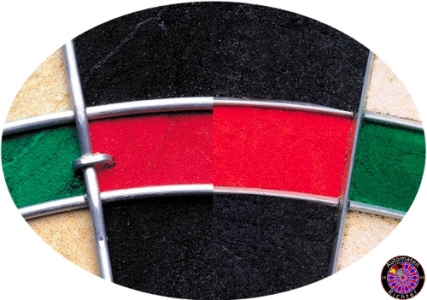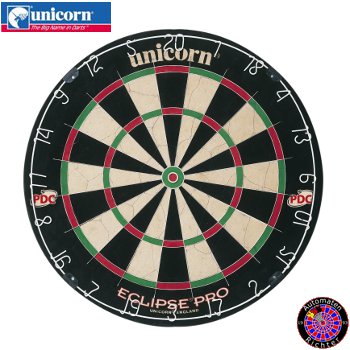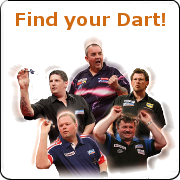Dart board
The invention of darts will not back a particular person. However, one knows that even before the first world war pubs in Britain had the first "arrow boards." These consisted of solid blocks of wood of the elm. They had to be soaked overnight in order to heal the holes left by the arrows. Later came a company called "Nodor" ("no odor") on the idea of modeling clay to manufacture the discs.
They used this clay to build an arrow board, but that the first of any great success. In the thirties, then somebody had the brilliant idea of making a dartboard out of rope or sisal fibers, which were very accurate. They tied together bundles of small sisal fibers of equal length and then pasted together a large amount of these bundles by a metal ring. Thus the first "bristles" was born-dart. It was an instant success, as the arrows little or no damage to the board left. As they parted only the fibers on the board when she struck, it took a relatively long time until the boards were broken and re-inking was no longer necessary!
Today, modern Dartboards Dartboards are constructed of sisal fibers and low quality are sometimes made of rolled paper. There are several different kinds of sisal, used for construction. They come mainly from East Africa, Brazil and China.
Very widespread nowadays are called electronic dart boards, which usually are made of plastic.
A rule-compliant board has a diameter of 47.08 cm (17 3 / 4 inches) and is divided into 20 segments. They have a value 1 to 20 The external focus ("single bull") is one 25 and the inner center ("Bull's Eye") is worth 50 points. Each segment is separated by a thin metal wire or a metal band. The best dartboards have a very thin wire to separate the sections so that the arrows are less likely to take these wires and bouncing it off the board. The figures, which will display the different values of the sections of the board, usually made from wire and (especially on tournament quality boards), but they can also be printed directly on the board.
Here you can see the difference between a conventional and a professional board:

Height and distance
In the standard game, the dartboard is so hung that the bullseye 1.73 m (5ft, 8in) above the ground depends. This corresponds to the eye level of a 1.83 m tall person. The distance of the throw line (oche) to the horizontal plate is 2.37 m (7 ft, 9 1/4in) for steel darts and 2.44 m (8ft) for soft darts.
Scoring
 |
The Standarddartboard is through the wires that run from the small central circle to the outer circle of wire, in 20 numbered sections (segments) and counts from 1 to 20 points. Circuit wires inside the outer wire subdivide each section into single, double and triple areas.
The picture to a steel-darts (Bristle) is mapped by Unicorn.
Modern (electronic) versions of the original darts are made of plastic. The so-called wires are also replaced by plastic.
Various games can be played using the Standarddartboards. In the game, any one of the arrow landing inside the outer wire as follows:
|
-
The meeting is one of the major parts of each of the numbered sections (traditionally colored alternately) is one of the point value of this segment.
-
The meeting of the thin outer portions of these sections doubled the point value of this section.
-
The meeting of the thin inner parts of these sections in the middle, between the outer wire and the central circle tripled the score of this section.
-
The central circle is divided into an outer ring with a value of 25 points (known as the "outer", "outer bull" or "iris") and a red inner circle (usually known as "bull", "inner bull" or "double bull "), with a value of 50 points.
-
The term "bullseye" can mean either the central part of the board or just the inner red section. The term "bull's ring" usually means just the outer ring. The meeting outside the outer wire counts for nothing.
-
Each arrow that - after he was thrown - does not remain stuck in the board (eg, an arrow that hits a wire and falls out of the board or by another throw rebounds), ranks also nothing.
However, there are also changes to this policy: eg an arrow, a referee who has made an obvious scoring section, but later dropped out, is to count when he is caught before it reaches the floor. If an arrow bounces back after a toss behind the throwing line, he can be thrown back.
The highest score, which is possible with three darts is 180, commonly known as "ton 80" (100 points is a ton [dt. For ton] called). This can be achieved if all three darts land in three times the 20th.
Types of dart boards
There are several types of dartboards. The most common are the following:
-
American Dart Board - larger double-and triple segments, no division of Bull's: the entire bull is worth 50 points.
-
Bristle boards (steel dart) - as described above, made of sisal, played darts with steel
-
E-Dart Boards (Softdart) - made of sturdy plastic; segments are provided with several small holes, often with automatic counter, plastic tip darts
-
Quadro board - between the bull and the triple-ring give it another narrow ring, which is one of the four times the value
-
Training Board - the double-and triple-ring is much narrower, or by the manufacturer of the patented One80, new way to train with the focus on a point



















 Information
Information Customer Service
Customer Service Extras
Extras Account
Account